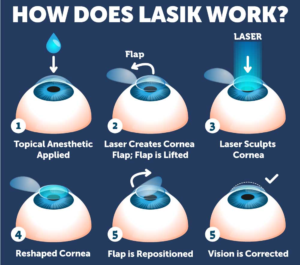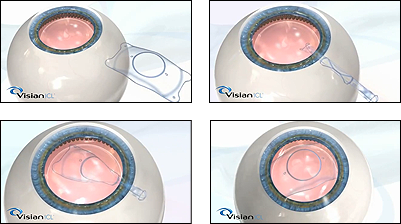What is it, and who is a good candidate?
Refractive surgery is elective surgery for the purposes of correcting a patient’s vision so they can eliminate or reduce the need for glasses and contact lenses.
 Radial Keratotomy (RK)
Radial Keratotomy (RK)
- This was performed in the 1970s and 1980s as a method of vision correcting surgery
- Radial cuts were made in the cornea in order to have it flatten its shape as it healed
- This flattening caused vision in near sighted people to improve
- The long term results of RK can be unpredictable, and many patients I have seen with previous RK are now very hyperopic.
- Can result in significant glare/halo, and can make additional vision correction difficult
- We will still see some patients that have had this, but it is not very common
PRK (Photorefractive Keratectomy)
- FDA approved in 1995 for the purpose of vision correction
- The first laser refractive surgery
- The top layer of the cornea (epithelium) is removed using alcohol and then underlying cornea tissue is reshaped to correct for the needed vision correction
- Over the next several days the epithelium regenerates, and vision improves as the cornea heals
- A soft contact lens is placed on the eye for the first few days to aid in pain relief and healing
- Can be an uncomfortable process (especially the first couple of days), long term results are very good
- Can be done on people with thinner corneas because no flap needs to be made like LASIK

LASIK (Laser Assisted In Situ Keratomileusis)
- Most common refractive surgery procedure that we will see
- FDA approved in 2000 for vision correction
- Similar to PRK, but uses an epithelium flap instead of removing the epithelium entirely
- Patient will have better initial results compared to PRK
- Much less uncomfortable that PRK
- Certain complications can arise from the flap that may need to be corrected with additional surgery or medication

ICL (Implantable Contact Lens)
- A different type of refractive surgery that uses an implantable lens situated between the iris and the lens
- Can be done on very high prescriptions where other methods are not an option
- It is a reversible procedure unlike other refractive surgery options
- Can cause complications like cataracts over time due to the contact between the ICL and the crystalline lens

RLE (Refractive Lens Exchange)
- Permanent implanted lens to replace the natural crystalline lens
- Depending on the IOL used, can correct for any type refractive error
- Can help near vision in presbyopia if a multifocal lens is used
- Can be performed after previous refractive surgery (LASIK, PRK)
- The same surgical procedure as cataract surgery
- Can be about twice the cost of LASIK
- Has the same risks as cataract surgery

Who is a good refractive surgery candidate?
- Stable refractive error (I will usually tell people 2-3 years of stability), I always recommend no refractive surgery procedure before age 25 because RX is still very likely to change at younger ages
- No other corneal disease (keratoconus, Fuchs, etc.)
- For PRK and LASIK the cornea must be thick enough (Higher RX requires thicker corneal because more tissue will need to be removed to perform correction)
- PRK and LASIK do not help presbyopia, so patient will still eventually need reading glasses/contact lens
- People with previous LASIK or PRK can still eventually get RLE

